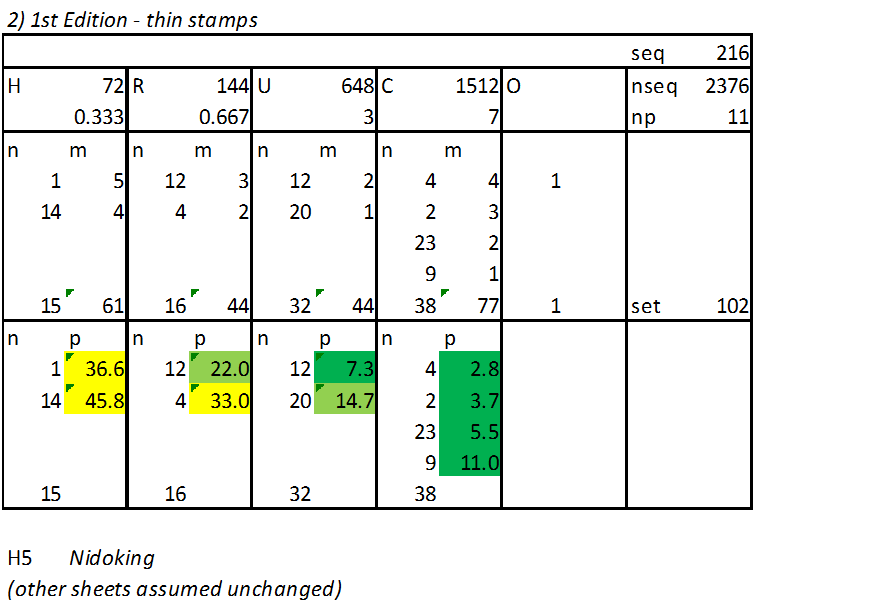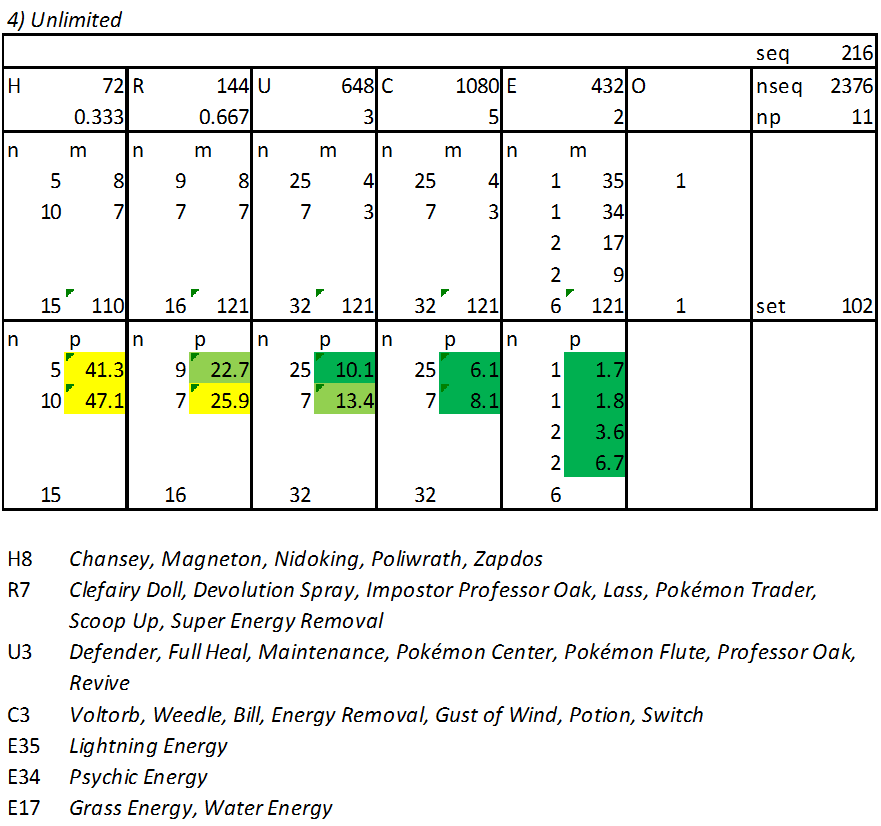Base Set
Base Set has four major variants: 1st Edition, Shadowless, Unlimited and “Base 2000” (i.e. with 1999-2000 copyright). Various uncut sheets are documented on Uncut Sheets. For the holo sheets, there are four known versions:
- 1st Edition - thick stamps: This sheet also includes 32 Machamps (for the 2-player starter decks) and 32 shadowless Mewtwo, Gyarados, Ninetales and Hitmonchan (for the theme decks). Only 35 cards of the sheet actually went into the booster packs. Also it is worth noting that it was a 9x11 sheet, most later WOTC holos sheets contain 10x11 cards and more modern holos sheets contain 11x11 cards.
- 1st Edition - thin stamps, and Shadowless - version 1: These two use the same layout, including 38 Machamps for the 2-player starter decks and 61 cards for the booster packs.
- Shadowless - version 2: This 9x11 sheet includes exclusively cards for the booster packs.
- Unlimited: This 10x11 sheet includes exclusively cards for the booster packs. Lacking any information to the contrary, it is the best assumption “Base 2000” used the same sheet layout.
For the various non-holo sheets, the following are documented:
- Unlimited and Base 2000 commons: 121 card sheet
- Unlimited and Base 2000 uncommons: 121 card sheet
- Base 2000 rares: 121 card sheet; since the Unlimited and Base 2000 commons and uncommons are both the same, this is assumed to apply to the rares as well
- Unlimited Basic Energies: 121 card sheet; a few cards on the sheet are obscured by objects placed on the sheet, but since the rest of the sheet is identical to both the Chinese Base Set the (English) Base Set 2 Basic Energies sheets, the sheet is assumed to be the same as these.
No non-holo 1st Edition or Shadowless sheets are documented.
In addition, some foreign language sheets are documented. The various Chinese sheets are all the same as the English ones. So too are the German and Italian holos sheets, but not the French commons, uncommons and Basic Energies sheets. While I don’t know the reason for sure, I suspect it may be because these were printed by Carta Mundi in Belgium which used a method called “striped collation” for scooping up the cards into stacks after cutting them. English Pokémon cards have generally used sequential collation, except for some print runs of Jungle and Neo Discovery printed in Belgium. The difference between these two methods is explained in detail on The Collation Project. Basically, striped collation leads to cards that were placed directly above each other on the sheet appearing in sequence in a booster pack, while sequential collation doesn’t (they appear in a “normal” left to right, top to bottom order, or vice-versa). Reorganizing the sheets may have been in order to avoid getting duplicate cards in one pack (e.g. 2 Defenders placed directly above each other on the uncommons sheet.) For the holos (and rares) sheets, this would not be an issue.
Let’s now look at the different print runs of Base Set and try to reconstruct the rarities, starting with 1st Edition and Shadowless. Logan Paul made two videos of 1st Edition Base Set box breaks, and there are a handful of other videos of people opening up 1st Edition or Shadowless booster boxes or packs. These videos lead to the following conclusions:
- The 1st Edition print run did not use the same commons, uncommons and Basic Energy sheets as the Unlimited print run did.
- For Shadowless, some packs and boxes used the same commons and uncommons sheets (see https://www.youtube.com/watch?v=eoHn5yt9e2A for example), while other did not (see https://www.youtube.com/watch?v=DSPrtcVMKRA).
I was able to reconstruct the “sheets” used for the 1st Edition and some of the Shadowless print runs of the commons, uncommons and Basic Energies. I use quotation marks because they are actually parts of sheets, likely of the same 121 card sheet: a sequence of 77 commons and Basic Energies, and a sequence of 44 uncommons. They look as follows (the dagger marks signifying the fact that it is impossible to tell the beginning and end of the sequences):
† Nidoran m, Diglett, Abra, Fire Energy, Starmie, Ponyta, Fighting Energy, Koffing, Pikachu, Doduo, Fire Energy, Gust of Wind, Machop, Lightning Energy, Gastly, Ponyta, Tangela, Grass Energy, Squirtle, Voltorb, Psychic Energy, Sandshrew, Weedle, Rattata, Water Energy, Drowzee, Poliwag, Fighting Energy, Charmander, Potion, Onix, Lightning Energy, Koffing, Magnemite, Psychic Energy, Pidgey, Abra, Metapod, Water Energy, Diglett, Staryu, Fighting Energy, Caterpie, Switch, Vulpix, Fire Energy, Voltorb, Machop, Grass Energy, Poliwag, Nidoran m, Rattata, Lightning Energy, Gastly, Doduo, Psychic Energy, Tangela, Sandshrew, Bill, Fighting Energy, Vulpix, Squirtle, Fire Energy, Pikachu, Bulbasaur, Drowzee, Grass Energy, Onix, Pidgey, Lightning Energy, Staryu, Charmander, Metapod, Psychic Energy, Energy Removal, Magnemite, Water Energy †
† Poliwhirl, Maintenance, Farfetch’d, Ivysaur, Pokémon Center, Machoke, Jynx, Full Heal, Kakuna, Double Colorless Energy, Porygon, Charmeleon, Maintenance, Poliwhirl, Raticate, Pokédex, Nidorino, Magikarp, Professor Oak, Magmar, Pokémon Flute, Porygon, Haunter, Energy Retrieval, Seel, Dratini, Double Colorless Energy, Growlithe, Wartortle, Full Heal, Dewgong, Defender, Kakuna, Magmar, Pokémon Center, Raticate, Seel, Revive, Nidorino, Kadabra, PlusPower, Dewgong, Super Potion, Arcanine †
The length of the sequences (77 and 44) which add up to 121 cards are too much of a coincidence to assume anything other than that they were printed on one single sheet and then separated before being inserted into packs.
That poses a problem, however: the ratio of uncommons to commons is too high (44 to 77 instead of 33 to 77 which would be required). That is why I propose the following idea: WotC used two sheets, one with 77 commons/Basic Energies and 44 uncommons, and one with 77 commons/Basic Energies and 44 rares. Doing so would have allowed WotC to economize the number of different sheets for printing the set to only three (including holos), plus those required for the starter decks and theme decks.
That would still yield a small surplus of uncommons and rares (depending of the exact ratio of the sheets). The 1st Edition uncommons in Shadowless packs mentioned in another thread (Identifying Shadowless & Unlimited Base set Boxes & Packs) could be an indication of such a surplus. The problem would have been resolved with printing pure Basic Energies, commons, uncommons and likely also rares sheets with the same design as those later used for Unlimited in appropriate quantities taking the existing surplus into account. That would mean that some Shadowless packs should exist which use the “new” commons and Basic Energies sheets while still using the “old” sheets for the uncommons and/or rares.
The proposed solution is also an elegant way to explain why red cheeks and yellow cheeks Pikachu exist in both 1st Edition and Shadowless versions: There is no need to assume some correction which applied to part of the 1st Edition print run but not to all of the Shadowless print run; instead, one of the two Sheets (commons/Energies/uncommons or commons/Energies/rares) likely had red cheeks Pikachu and the other had yellow cheeks Pikachu.
Thus, the rarity tables look as follows:
For 1st Edition, it is noteworthy that there are pretty significant, if non-artificial, differences in pull rates, particularly between the different commons and uncommons. A noteworthy example is Bulbasaur compared to Charmander and Squirtle. This difference, and not only popularity of the Pokémon, may explain the differences in the PSA population report, which for 1st Edition lists 4345 Charmander, 4179 Squirtle and only 2273 Bulbasaur.
The table for Shadowless reflects the fact that it is not known which combinations of different sheets were used in packs, thus all variants are shown together. The sheets presumed to be printed later (a Shadowless-exclusive holos sheet as well as commons, uncommons and Basic Energies sheets matching those used for Unlimited) are highlighted in grey.
For the Unlimited print run, the Energies sheet is noteworthy because the differences in rarity between the various Basic Energy cards are very large. They can be explained as follows:
- Fire and Fighting Energy appeared both in the 2-player starter deck as well as one theme deck each, and thus appear the least frequently in the booster packs.
- Grass and Water Energy appeared in two theme decks each, and appear moderately frequently in the booster packs.
- Psychic and Lightning Energy only appeared in one Theme deck, thus they appear the most frequently in the booster packs.
I noted down the Energy cards obtained from two box opening videos on Youtube and these rarities appear to be confirmed.
Aside from that, no artificial rarity difference between cards of the same nominal rarity are introduced. For the Unlimited print run, the trainer cards tend to appear on the sheets fewer times than the Pokémon when there are non-artificial rarity differences, and on the Unlimited holos sheet, the final evolutions of the starter Pokémon as well as the four holos appearing in the theme decks are among those appearing once fewer.
Edit 2023/02/24: replaced image (one R7 card mistakenly omitted)
Edit 2023/03/16: edited information regarding use of striped collation in English sets
Edit 2023/04/19: completely rewritten and tables updated with data for 1st Edition and Shadowless commons, uncommons, Basic Energies and rares



